Single Spotlight: 2017 Special

With less than a week left to go before the dawn of 2018, today, I’m not looking at one individual spoiler; this week, I’m going to look at where we’ve been in 2017, from Aether Revolt to Ixalan, and from Heart of Kiran to Carnage Tyrant.
2017 was a pretty rough year for competitive Magic. We started the year with a pre-emptive ban prior to Aether Revolts’ launch of Emrakul, the Promised End, Smuggler’s Copter and Reflector Mage. Immediately after this, Felidar Guardian was spoiled, and “Splinter Twin” found it’s way into Standard. To the surprise of no-one, just a few short months later, we lost Felidar Guardian in a heel-turn emergency ban that decried Wizards’ usual practices. Just when players had taken a breath and were ready to take stock of their position, Aetherworks Marvel picked up right where it left off before the Cat came into play and dominated tournaments worldwide. Before Hour of Devastation ever made it to shelves, the Marvel went, and everyone hoped things would be marvellous.
… and they were. Hour of Devastation Standard was probably the best Standard format I’ve played since Shadows Over Innistrad’s release. From there, we took a turn into Dinosaur-territory, and the rotation and introduction of Ixalan shook things up once more. While there are plenty of players eyeing up Energy decks for a potential ban, I don’t see Wizards banning what is basically the Jund of the format. At this very moment, the waters are pretty still, and we’re all eagerly waiting to see what ingredients Rivals of Ixalan brings to the Standard stew.
So, what cards impacted the format most this year? What incentivised the various bans, and what strategies were so overpowering as to necessitate a swing of the hammer? What is still powerful now, and likely to continue to be so?
Top 8 Cards

Heart of Kiran and it’s cronies in Mardu Vehicles more-or-less single handedly kept the four-colour Saheeli decks in check. A turn two Heart on the draw meant the opponent could not comfortably slam their Saheeli on the table, and did double duty shooting down Gideons and Chandras all over. The savvy player recognised that Kiran’s real power lay not in it’s absurd stats, but in the threat of it’s stats. Against open mana, a turn two Kiran would often curve into a Scrapheap Scrounger, and then pass. What is your opponent to do? Waste their mana? More than likely, that Harnessed Lightning that lay in wait would fry the Scrounger, and the Heart would continue to deter the opponent from tapping out. Kiran has seen sporadic play of late, no doubt in no small part due to Abrade. Had Abrade been legal during the Saheeli-Mardu format, I don’t know if Mardu would have been able to keep up!
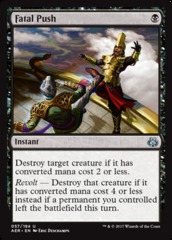
The only card on this list to have made it’s mark in not only Standard, but also Modern, Legacy and Vintage is Fatal Push. Push is a powerful play in Standard, for certain; killing an opposing two-drop on the draw into casting your own two-drop effectively robs the opponent of the play while keeping the extra card; but Revolt isn’t trivial, and most decks will play five mana (and up!) creatures. In eternal formats, fetchlands enable Revolt without a bat of the eye, and you’ll find that basically every creature to see play dies to a good hard shove. Tarmogoyf? So long. Death’s Shadow? Buh-bye. Spell Queller? Whoops! Nonetheless, Fatal Push is a Standard staple and reason to play Black, and will continue to be until rotation in September. I wonder whether Smuggler’s Copter would have continued to be quite the problem it was if it had stuck around to be punted off a cliff?
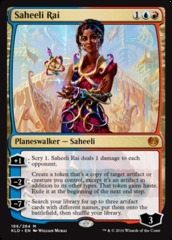
Ah, Saheeli. On Kaladesh’s release, many players tried various combos or value-shells to abuse her ability to replicate creatures and artifacts. If one Verdurous Gearhulk is good, two is back-breaking. Still, her inability to protect herself without help and lack of straight card draw relegated her to the trade binder of players everywhere. Then came the Cat. Felidar Guardian with Saheeli created an insta-kill combo remiscent of Modern’s own Deceiver Exarch/Splinter Twin; a combo that was deemed too powerful for Modern! Somehow, Wizards decided to let this one through the doors and see how it played out. For a month or so, it didn’t make too many waves, as players tried to copy the example set by Modern with Jeskai Control being the preferred home. Had the story ended there, CopyCat would have likely not been banned. Enter four-colour Saheeli. Using the powerful Energy package, CopyCat played a midrange game with a combo kill – it could kill on turn four or grind with the best of them, and threatened the win if ever the opponent tapped out. This Cat definitely needed to be put down, and now, Saheeli once again languishes in the jank box. She’s around until September, mind, so I’d keep an eye for cheap and effective ETB abilities. She could yet make a return.
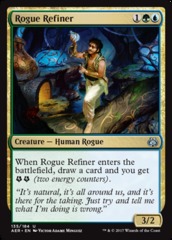
If the Energy package forms the legs of Standard’s table, Rogue Refiner is the glue. Refiner offers so much, and asks so little – for the low cost of three mana, you get a serviceable 3/2 body, you get your card back, and you even get some proportion of a card with the two energy. Two-thirds of a Whirler Virtuoso Thopter per Refiner isn’t an awful rate! Refiner bridged the gap between Saheeli’s early setup and then it’s combo, it fuelled up the Aetherworks so you got a spin at a Marvel, and to this day it helps smooth your draw and curve into a Bristling Hydra or Glorybringer. The numerous Refiner hands give Control fits, they grind the mirror down, and after all that, they trade off with opposing Refiners beautifully. Rogue Refiner is the reason why Jund Energy has to take a swim to be viable, and why Sultai and Temur Energy are the go-to colour combos. Refiner is among the most played uncommons in Standard, and I can guarantee that is not going to change so long as he’s around.
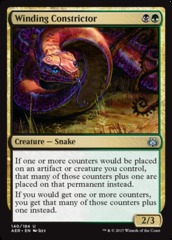
Hiss hiss. Winding Constrictor, or the Snek that could, offers a Hardened Scales on a stick. Given how little play Scales saw in Standard, this should illustrate the power you gain when a useful effect is tacked onto a live body. The Snek creates games that snowball out of control incredibly quickly, whether he is accompanied by a Rishkar, Peema Renegade, Longtusk Cub, or Walking Ballista. The Snek has been a Standard mainstay since it’s first printing, and while the strategies it plays in have ebbed and flowed from the top to the bottom of the metagame, this is one Snake that has sunk it’s teeth into Standard and isn’t letting go. Even as recently as the last Pro Tour, Seth Manfield proved that you can’t keep a good Snek down with his Sultai Energy list (though at this stage I wouldn’t be shocked if he top 8s Pro Tour Rivals of Ixalan with a literal ham sandwich). So long as the Snek is with us, expect many games to end on turn three after a quick Longtusk Cub/Snek/Fatal Push curve.
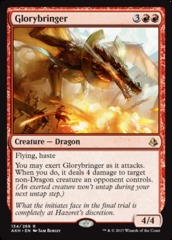
I’ve compared Glorybringer to Stormbreath Dragon favourably before, and I’m going to reiterate that statement – Stormbreath was powerful. Glorybringer is nuts. Glory acts as a Planeswalker, nabbing immediate value after fly-by roasting any poor unsuspecting Rogue Refiners, and then demanding an answer before you get to untap. If the first Glory wasn’t lights out, these Dragons are like Siege Rhinos of old; they come in pairs. Even against creature-light decks, they can fall back on the being-Stormbreath-Dragon plan, and ensure a speedy recovery from an ill-timed Fumigate. To top it off, Glory is the bane of Planeswalkers, and more or less by itself shot the stock of Gideon, Ally of Zendikar through the floor while they were both legal. If you’re into Standard and don’t have your playset of the Dragon, I’d pick them up now. If you’re a deck with red mana, whether Temur Energy, mono-Red or even UR Control, you should probably have a nest of these in your seventy-five.

The card that spearheaded the return to form of Red Deck Wins, Hazoret is part of the nuttiest nut-curve that we have in Standard. Bomat Courier/double one-drop/Ahn-Crop Crasher/Hazoret the Fervent is not getting beaten a lot. Hazoret offers a fast clock, a resilient threat, and a mana sink all for the low, low cost of four mana. As a non-religious man, it’s deities like Hazoret that get me to believe.
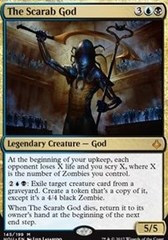
What can be said about The Scarab God that hasn’t already been said by both me and the entire internet? The Scarab God is a $50 Standard card, and worth every cent. It’s because of this God that decks like UB Control even exist over UW or UR. Cast it, untap, and enjoy your auto-win games.
Summary
Standard has had a pretty tricky year. From ban to ban and controversy to controversy, players have had to contend with numerous two-card combos and overpowered Mythics. That said, the night is always darkest before the dawn; I think the sun rose pretty quickly around the launch of Hour of Devastation, and is only rising brighter as we head along with the sun-soaked Rivals of Ixalan. What dominant forces do you think I missed above? Should Abrade have made it into the top 8? What about Approach of the Second Sun, God-Pharaoh’s Gift, Drake Haven, or even Hostage Taker? Leave a message in the comments below, and get yourself fired up for the Dino-Vamp-Fish-Pirate bloodbath that Rivals promises.
I’m looking forward to 2018, and I hope you are too! As always, thanks for reading, and good luck.





